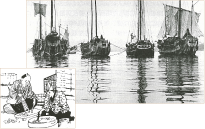The History of Sweets in Hokkaido
-
During Japan’s Edo Period, which lasted from 1603 to 1868, Hokkaido was still known by its former name of “Ezo-chi”. It was during the Edo period that sweets were first made in what is now the southern Hokkaido area, near the main island of Honshu. This region was administered by the Matsumae Clan. For example, it’s said that when the Matsumae Clan attended on the shogun at Edo (now Tokyo), they brought not only gifts of seafood, but also yokan (sweet bean jelly) and booro (small cookies).
Sweets were made not only in Matsumae (the only castle town in Ezo-chi), but also in Esashi and Hakodate, even before the Meiji Restoration (1868-1912). After the Meiji Restoration, development and settlement of Hokkaido begun, and alongside these efforts, the confectionary industry flourished in cities such as Otaru, Sapporo, and Asahikawa. Sweets makers earnestly competed, creating a number of original sweets particular to each region. Confectioners also started to formed associations to collaborate with their industry colleagues in each region.Around the Second World War, Hokkaido’s confectionary industry was moving ahead at full steam. And, as Hokkaido became a popular tourist destination, many unique Hokkaido sweets became prestigious throughout the nation.
Hokkaido’s history is relatively short compared to the other prefectures of Japan. However, Hokkaido’s abundant supply of excellent ingredients, and the neverending determination of its pioneering people have created a deeply-rooted history of wonderful sweets throughout Hokkaido.
-

From the Edo Period to the Meiji Period, the "Kitamae-bune" cargo fleets played a major role in transporting goods over the Sea of Japan. Cargo ships headed from Honshu to Ezo-chi were loaded with foodstuffs, seasonings, and sweets.